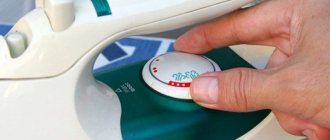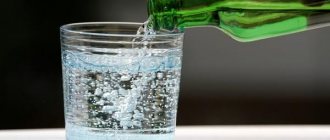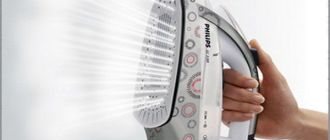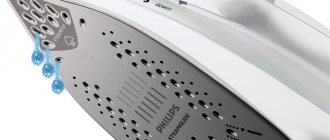How to clean an iron from burnt soles made of different materials
There are many methods to remove burnt marks, but only after finding out the material from which the sole of the iron is made. This will determine what means you can use to work with it. So, how can you clean your iron from carbon deposits without damaging the coating at home?
No. 1. Cleaning an iron with an aluminum soleplate
Among the characteristics of aluminum are high thermal conductivity, low cost, light weight, but it is easy to scratch and bend. Cracks that are invisible to the eye have a bad effect on ironing clothes; dust and dirt get into them. They are quite difficult to clean, because... abrasive powders and brushes can only make the situation worse.
Many manufacturers, taking care of the durability of the surface, coat the metal with special means.
An easy way to remove dirt from such soles is to use regular toothpaste without microparticles, add a little vinegar and foaming dishwashing detergent.
After removing carbon deposits, wipe the surface with a thick woolen cloth. It will even out invisible scratches and protect the device in the future. Toothpaste can be used to polish the surface well.
No. 2. Cleaning your ceramic iron
The sole, made of ceramic, is highly resistant to carbon deposits and also provides easy gliding when ironing.
The main problem that owners of such irons face is the formation of scale, which makes it impossible to use the steam holes. Fill the iron with filtered or settled water.
Ceramics are fragile and require careful handling, so it is better not to use aggressive cleaning agents. Wipe the surface with vinegar or hydrogen peroxide. At the end of the article this method is described in more detail.
No. 3. Cleaning an iron with a steel sole
Stainless steel can withstand active external influences. Unlike others, steel soles can be washed with abrasives: toothpaste, soda, tooth powder. You can buy a special cleaning pencil, or you can get by with vinegar or citric acid.
You can remove the newly formed smoke with a wooden kitchen spatula. Do not use metal utensils such as knives, you will damage the sole.
No. 4. Cleaning a Teflon-coated iron
There is no Teflon iron, you need to remember this. Teflon coating is a thin layer of a special material that is applied over stainless steel or aluminum. When washing, it is better not to forget about the technical characteristics.
This iron is great for ironing silk fabrics and other lint-free materials. It will cope with any creases at minimum temperatures. The iron has a relatively low price and an impressive service life. Teflon coating is one of the most common on the market.
Unfortunately, it is easy to scratch. How to clean a Teflon iron from carbon deposits without damaging the surface? An easy way to remove dirt is to rub a little citric acid over the surface with a soft cloth. Use a cotton swab to remove dirt from the holes.
Teflon coating is also convenient to clean with vinegar, toothpaste without adding microparticles (abrasives) or a special pencil.
The pencil can be purchased at a hardware store. It contains acids that, when heated to 1400C, clean the surface. Make sure that pencil particles do not get stuck in the steam holes.
After all the manipulations of cleaning the sole, heat the iron and smooth it with a soft cloth that you don’t mind getting dirty or damaged.
No. 5. Cleaning an iron with a titanium soleplate
This coating is applied to stainless steel. It is the most durable, strong, it is difficult to scratch and break, nothing sticks to it. The disadvantage of titanium coating is its high price and long heating time.
Any method, both abrasive and gentle, is suitable for cleaning a titanium sole. You can resort to a chemical method with vinegar or ammonia (read more about these methods below).
Carbon deposits can be easily scraped off the titanium layer with wooden blades or metal brushes.
No. 6. Cleaning the enamel soleplate of the iron
The enamel is difficult to scratch and is resistant to chipping and cracking. The disadvantage is that with long-term use, microholes and enamel detachments appear, even with gentle use. Cracks in the enamel affect the quality of ironing.
The enamel sole can be cleaned with toothpaste, citric acid, ordinary vinegar, soda or tooth powder with water. To scrape off carbon deposits, use a wooden spatula or a brush with fine bristles.
Cleaning the iron from burnt marks on the sole
If the heating mode of the iron is incorrectly selected, a yellowish coating forms on the sole. It makes the sole rougher, which makes it glide worse on the fabric and makes ironing more difficult. If this deposit is not removed in time, it will turn brown, then black. The darker the color, the more difficult it is to get rid of plaque. If your iron is expensive, it is better to remove plaque after ironing. Ideally, immediately after it appears. Even if you do gentle cleaning once a week, this will be enough.
Soot/burn on the soleplate of the iron stains things and makes ironing more difficult.
Cleaning method at home
First, how to clean the soleplate of your iron. Take a clean, dry cloth made from natural fabrics. It would be very nice if it had a rough weave, but it is not necessary. The rag needs to be folded several times and placed on an ironing board. We apply a liquid or paste composition onto it, distributing it over most of the surface. Using an iron preheated to medium temperature or a cold one, we begin to “iron” the rag with the cleaning agent. This should be done for several minutes. It is advisable to remove the plug from the socket during cleaning. Alkaline or acidic components are usually used, so it is better not to take risks, otherwise you will also have to repair the iron.
In most cases, simple home remedies work
In some cases, if the rag is saturated with caustic components, you can simply leave the iron on the rag for a while. When the carbon deposits soften, you can iron it with a dry or damp cloth, but this one is clean. If not all carbon deposits have been removed, repeat the treatment. If it doesn’t help at all, try another method or composition.
When using certain cleaning compounds (baking soda, salt, toothpaste), the steam release pores on the soleplate of the iron may become clogged. A rag soaked in vinegar can help. We also iron it with a heated iron. Another way is to add water and vinegar and “release” all the liquid in the form of steam. Keep the sole pointing downwards. This, by the way, will also clean the scale that forms in steam irons.
Cleaning compounds
To say unequivocally - this works, but this doesn’t - it won’t work. Firstly, the type of burn is different. Secondly, the ironing soles are also different. Not only the shape is different, but also the materials. What works on ceramics may not work on metal. And vice versa. Often you have to try several options. What's interesting is that what worked this time won't necessarily work the next time. So you constantly have to experiment.
You can do it differently: apply the paste to the fabric and “target” rub the stains
Composition for application to clean fabric:
- Mix baking soda and detergent, add water until it becomes a thick paste.
- Whitening toothpaste.
- Add a couple of tablespoons of ammonia to 9% or 6% vinegar and moisten the cloth.
- You can try just vinegar. You can wet a rag with it and rub the sole with it. But “ironing” a rag soaked in vinegar is safer, and you can scrub off particularly stubborn stains.
Vinegar works well on some types of stains
There are also more aggressive methods. For example, take 20-25 grams of citric acid for 200 ml of water. Pour the solution into a frying pan or baking sheet with high sides. Place the iron in it. The liquid should cover the sole, but should not exceed the connection level with the body. Leave for 20-25 minutes. Even the toughest carbon deposits are wiped off. If you put the iron in a frying pan or baking sheet on low heat and boil it, also thoroughly clean the limescale deposits that clog the steam nozzles. The liquid should not boil, but only be hot.
A tougher option is a bath cleaner with acid or alkali. Again, different formulations work for different cases. Place a piece of thick polyethylene on a soft rag and press it down a little in the middle so that the edges are higher than the middle. Pour the product and place the iron in the resulting puddle. The burnt spot on the sole should be immersed in acid. Wait 10-15 minutes, wash with a wet cloth. Even tough stains come off so well. If the soleplate of the iron is made of stainless steel, you can safely use this method. All others are at your own peril and risk.
Dry cleaning
There is also a method of mechanically cleaning the iron from carbon deposits, but it can be used with cheap or old copies. With those where the surface is made of ceramics and has a Teflon coating, these methods will not work. Or rather, they will remove the fumes, but the sole will get a lot of scratches, so it will be almost impossible to use. So before you clean the iron from carbon deposits mechanically, we look at the sole. If there are already scratches and it doesn’t bother you, feel free to proceed. If the surface is smooth, it is better not to take risks and try liquid products.
Cleaning method: rub an iron over a pile of baking soda or salt
The essence of the method is to pour dry fine abrasive and move an iron over it until burnt fragments remain on the abrasive. We act like this. On a hard surface, spread a sheet of paper (you can use a newspaper, a magazine spread), pour in baking soda or fine table salt. We heat the iron a little (do not heat it), pressing it against the dry substance, trying to peel off the burnt residues. The cleaning time depends on how much the carbon deposits have become stuck. Sometimes the process goes quickly, sometimes slowly, but it always cleanses. Not to a mirror shine, but it does remove the blackness.
The disadvantage of this method is that if there is carbon deposits inside the recesses of the iron sole, it is very difficult to remove. You will have to take a cotton swab, dip it in water, baking soda/salt and clean each hole in this way. The boiling method works faster.
You can remove burnt marks from the gray sole from a matchbox
There is another method of mechanical purification - using sulfur on an ordinary matchbox. The sulfur strip is a fine and soft abrasive. It should not even scratch the ceramic surface. Cleaning carbon deposits from the iron is simple: scrape off the carbon deposits with the corner of the box.
Using a pencil to clean your iron
There are special pencils on sale for cleaning the soleplate of the iron. They may have different compositions, but the cleaning process itself is the same. First you need to protect the plastic part of the body, which is located below the sole. Masking tape is ideal. It sticks easily, holds well and leaves no marks after peeling off. We seal the plastic carefully.
It is easy to clean the surface of the iron with a pencil. And it only takes a few minutes. Preparation takes longer.
You will also need a clean rag or paper towels to clean the surface of residues and drips. We put thick cotton work gloves on our hands - steam will be actively generated and the gloves will protect against burns. It is better to cover the table with paper or old rags - dirty liquid will flow. Next, clean the soleplate of the iron as follows:
- Preheat the iron to medium temperature or higher. The higher the temperature, the faster the cleaning will take place. But the fumes are very active, so ventilation should work well or you can clean it near an open window.
- Tilt the iron so that the sole is pointing slightly downward. We choose the angle arbitrarily, but the composition from the melting pencil should not flow inside through the steam holes.
- We actively move the pencil along the sole of the iron. It melts, evaporates immediately, and some of it drips down.
- Periodically clean the surface with rags or paper towels. When all the stains come off, wipe the sole clean and remove the tape.
The result is unexpectedly impressive
This method is one of the most effective. The price is a couple of tens of rubles, but it can be used for Teflon, steam, and ceramic irons. Fast, convenient, inexpensive.
Store-bought iron cleaning products
Before you clean the iron from burnt marks on the sole using purchased products at home, you need to familiarize yourself with all types of compositions and devices. Let's look at them in order.
No. 1. Pencil
It will help remove plaque and dirt quickly and without damage. It consists of ammonia, which serves as a cleaner.
Mode of application:
- heat the iron well (~150 degrees);
- put it on a stand and rub it with a pencil;
- turn it off and wait for it to cool down;
- Use a soft cloth to wipe away any remaining composition.
Dirt and dust will come off with the product.
Important: do not cover the steam holes, otherwise you will have to clean them.
No. 2. Sole backing
If your iron has burnt fabric or the steam generator is dirty, then this unique rug will handle it. It will last a long time with proper use.
It must be placed on a table or ironing board and ironed with a cold iron. Then wipe with a wet cloth.
If you wash the steam generator, you need to fill it with water and turn on the self-cleaning mode. It will knock all the dirt out of the holes. Then the sole should also be wiped.
No. 3. Sponge
There are all kinds of products on the shelves, including sponges. Use them for any type of dirt. You can take sponges if you want to clean old carbon deposits on pans and pots. The main thing is not to rub the non-stick coating.
The sponge needs to be thoroughly wetted, and then used as usual for washing dishes. Finally, rinse the soleplate of the iron with a wet, clean cloth and wipe dry.
No. 4. Liquid cleaning solution
They are sold in bottles with labels detailing the method of use. Before purchasing, find out which sole material is suitable for a particular product.
The liquid copes well with all types of dirt and also protects the sole from further deposits. Especially often, special solutions are purchased to remove burn marks from synthetics, polyethylene, plastic, etc.
Cleaning methods
Now let's look at how to wipe off carbon deposits and what techniques are best suited for different types of materials.
Pencil
In difficult cases or if there is no desire to select a traditional recipe, there are special pencils for use at home. They are sold in hardware departments or hardware stores next to the irons.
This gentle cleansing can be used on all types of soles. The scheme of actions is very simple.
- Heat the equipment to the temperature specified in the instructions.
- Drag the chalk over the hot surface, paying special attention to difficult areas. Under the influence of temperature, the pencil will begin to melt. Do not press too hard to prevent the rod from breaking and crumbs from getting into the steam holes.
- Use a cloth to remove any remaining dirt.
- When the device has cooled down, wipe it first with a wet and then with a dry cloth to remove any remaining product.
Please note that acrid smoke is released during operation. Therefore, manipulations should be carried out in a ventilated area and try not to inhale fumes.
The price of such devices varies greatly. You can find budget options, or you can choose expensive branded cleaners. I speak from experience: there is no difference between them.
Another addition: place unnecessary rags under the unit, because during cleaning, pencil drops flow down, forming stains.
Vinegar
There are many options for using acid to get rid of burning.
- The simplest: suitable for small stains. Use a piece of cotton wool soaked in table vinegar to treat the stained area. There is no need to heat the device.
- In more complex situations, prepare a vinegar solution: a couple of tablespoons per glass of water. Soak an unnecessary towel with this mixture and iron thoroughly with an iron preheated to medium temperatures.
- Solution for the lazy. Soak a piece of cloth in vinegar and place the still warm device on it. Let it sit like this for several hours.
- If the situation is very difficult, mix the acid with ammonia in a 1:1 ratio and walk over the surface.
Vinegar has a specific odor and can cause burns to the respiratory tract. Therefore, all procedures should be carried out with open windows and wearing a protective mask.
When the procedure is completed, be sure to rinse off any remaining acid with clean water.
Soda
A fine abrasive allows you to quite carefully remove traces of soot and rust, but is only suitable for metal. Teflon and ceramics are damaged from such manipulations.
In a small bowl, mix baking soda and water to a paste. Apply the mixture onto a cloth and gently rub the sole in the burnt areas. Next, remove the powder particles with a wet sponge.
Salt
You definitely have salt in your kitchen, so it will help out in cases where there is nothing else suitable. If possible, try gentler methods first, as salt leaves scratches.
Sprinkle a small amount of salt onto a clean piece of paper or cardboard. Iron it with a hot iron without much pressure.
Another option: put a couple of tablespoons of salt in a cotton bag and wipe the heated surface of the device with this package.
For stubborn stains, you can enhance the effect with vinegar. Add salts to the acid in a 1:1 ratio. Keep this mixture on low heat until the crystals are completely dissolved. Use a cloth soaked in the solution to wash off stains. Just remember to put on gloves first.
Those places where the dirt is very strong can be carefully scraped with a plastic spatula. Finally, remove any residue with a sponge and water.
Laundry soap
This is truly a folk remedy! The range of its applications is very wide, and it also includes the removal of burns. It is better to use soap for fresh marks.
It would be correct to start work immediately after the trouble has occurred. Simply rub the soleplate of the iron with a bar of soap, and then go over it with a soft cloth.
You can act differently.
- Mix a tablespoon of grated soap in a glass of water.
- Use a rag to clean the surface and remove as much carbon deposits as possible.
- Apply the prepared mixture to a warm sole and leave for 15–20 minutes.
- Wipe with a damp piece of cloth to remove soap scum.
Solvent
Nail polish remover, acetone or any other solvent you happen to have on hand will do. With their help, you can quickly remove traces of melted polyethylene.
Please note: the iron must be cold!
Soak a cotton pad in a small amount of liquid and rub the affected area. After all excess has been removed, go over the base with a damp cloth.
A few more methods
In addition to the above, there are other quite effective cleansing techniques.
- Hydrogen peroxide – soak a cotton pad in 3% hydrogen peroxide and rub the affected areas vigorously. Unnecessary plaque will dissolve and come off quickly. The device must be cold!
- A matchbox is an unexpected solution, but, judging by the reviews, very effective. Take a new box and treat the heated sole with the side on which the match is lit.
- Foil – I personally tried this recipe and confirm that it works. Just take the foil and iron it with a hot iron. The burnt material will flake off and stick to the metal sheet. When dirty, turn the foil over or replace it with a new one.
- Toothpaste is a delicate polish that removes dirt well. Squeeze out a little paste and brush the lukewarm surface with a soft brush in a circular motion. All that remains is to walk over it with a wet cloth.
- Candle – wrap a regular paraffin candle in cotton cloth. Pass this workpiece over a hot iron, pressing lightly in the most affected areas. The unit should be held at an incline so that drops of paraffin flow down and do not clog the steam holes. So lay newspapers down or place a tray.
You will learn several additional options for dealing with soot from the video.
Homemade methods for cleaning iron soles from burnt marks
There is no need to waste time looking for pencils or mats. Any housewife will have something that will be no less easy to clean the iron from burnt fabric at home.
No. 1. Citric acid or vinegar
The main thing is to take your time, do not inhale vinegar fumes and work with an open window.
- Soak a clean cloth well in vinegar, heat the iron and rub the soleplate until all the dirt remains on the rag.
- Instead of a rag, cotton pads or unnecessary jeans will do. Finally, you need to iron the old item, removing any remaining vinegar. This method works great on almost any stain.
- Instead of vinegar, you can use citric acid, as well as regular lemon juice. Squeeze it into a glass of water and use it according to the scheme described above. The sole will quickly clean and shine as after purchase.
No. 2. Salt
This method cannot be used on soles that are easily scratched, such as Teflon coatings.
- Sprinkle salt on the table or ironing board on top of a towel or paper. Then warm up the iron thoroughly and rub the soleplate on the salt.
- Over time, the crystals will begin to darken. This means that you can turn off the iron and check how well the dirt has been removed.
- If you are not pleased with the result, repeat the cleaning regimen using fresh salt.
It is better to heat the iron well, because with a cold iron the process will take a long time and you will have to put in more effort.
No. 3. Cleaning with a matchbox
Such an unusual method really exists; many housewives actively use it.
- For these purposes, you will need a box with a red phosphorus part on the sides. It is necessary to thoroughly rub the stain, and then walk with a soft cloth.
- How to clean the iron from carbon deposits with a box if you couldn’t wipe off the carbon deposits the first time at home? For a better effect, you should repeat the procedure - heat up the iron and take a new box.
This method will help remove the most stubborn stains, but it is quite aggressive, so do not use on delicate surfaces.
No. 4. Soda
Soda or soda paste will help remove complex dried carbon deposits. All manipulations are carried out using a cold iron.
- It is necessary to mix the powder with water in a 2:1 ratio until it becomes sour cream.
- Apply for a few minutes, then clean thoroughly. Finally, rinse with a cloth and wipe to remove any residue.
- You can mix the powder with dishwashing detergent. The cleaning scheme will be exactly the same.
Remember that soda, due to its structure, can damage the coating. If you have a Teflon sole, do not use a dry substance, give preference to a paste.
No. 5. Laundry soap
Many people are interested in the question of how to clean the soleplate of the iron when there is a burn from stuck synthetics? This often happens if you set the temperature incorrectly and iron the item in a hurry. But there is a way out - laundry soap.
In fact, you can use any solid soap, but household soap has a special, effective composition. It even copes with old carbon deposits that are not amenable to other methods.
How to use:
- grate soap shavings;
- mix with water so that it does not turn out too liquid;
- Apply the composition to the sole with a regular dishwashing sponge;
- leave for 10 minutes;
- Rinse off any residue and wipe dry.
It doesn't matter whether the iron is hot or cold. If you have warmed it up, you need to wash off the soap after the sole has cooled down.
No. 6. Hydrogen peroxide
The simplest way possible, peroxide is available in any pharmacy.
It's very easy to use:
- wet a piece of cloth;
- iron it with a hot iron;
- rinse off the residue with water and dry the sole.
This way you can even clean the Teflon coating without fear of scratching.
Hydrogen peroxide is also sold in tablet form called hydroperite. It must first be diluted in water to a thick state or, like a pencil, rub the surface.
No. 7. Nail polish remover
If the coating of your iron can be easily damaged, gentle cleaning with nail polish remover is suitable:
- soak a cotton pad in the product;
- walk it through dirty places;
- Remove any remaining residue with a clean cloth.
Before cleaning the iron using this method to remove burnt marks on the soleplate, it is important to know one detail - at home, do not use acetone on a Teflon coating. But it is allowed to use nail polish remover, which does not include it.
Do not allow the product to come into contact with the plastic parts of the device to avoid damaging them.
No. 8. Toothpaste or powder
An excellent product for cleaning soles is ordinary toothpaste. Now everything is cleaned with it, from white sneakers to gold jewelry.
She can also cope with carbon deposits:
- apply the paste to the stains;
- scrub with an old toothbrush;
- rinse with water.
It will be effective to warm up the iron with the paste applied to it. Then remove the residue along with the scale using a cloth.
No. 9. Ammonia
Since you can easily clean the soleplate of your iron at home with ammonia, why not take advantage of this opportunity?! Ammonia can be called universal.
It will cope with the problem of iron contamination:
- Plug in the household device and warm it up;
- soak the cloth in ammonia;
- clean the heating element from dirt;
- iron a clean unnecessary item - all the dirt will remain on it.
There is another way: wet the stains and leave them overnight, and in the morning remove the remaining dissolved dirt.
Ammonia can be combined with vinegar to create an effective mixture.
No. 10. Paraffin or candle
Using a candle, in addition to burning, you can clean the iron from scale. It is better not to get it into the holes, because paraffin is quite difficult to remove.
Instructions:
- heat the iron higher than 170 degrees;
- place on paper or waste cloth;
- carefully rub the candle over the surface;
- the paraffin will melt and flow onto the paper along with the dirt;
- To completely remove its remnants, smooth out the unnecessary item.
Candles will not cope with old stains or carbon deposits from synthetics.
How to clean carbon from an iron - 10 effective ways
No matter how high-quality an iron you use, at some point in time you will encounter the problem of carbon deposits on the iron! A small mistake and the iron cannot be used. However, don't despair! In this article you will learn how to clean carbon deposits from your iron. Cleaning the iron with improvised means First, you need to stock up on everything you need. You will need coarse table salt, a paraffin candle, a soft cloth, hydrogen peroxide, a matchbox, table vinegar, soap, baking soda and nail polish remover. Any housewife can find all this. So you can quickly and easily start cleaning your iron from carbon deposits. Attention! Use all of the above methods at your own peril and risk, in some cases you risk damaging your iron, so be careful!
Method 1: Sprinkle a little salt on a thick sheet of paper. Heat the iron very high and move it over the salt crystals until the carbon deposits come off. For a better effect, add finely ground paraffin from a candle to the salt.
Method 2 Wrap a paraffin candle in thick cotton cloth. Then scrub the candles with a hot iron. The candle will melt, so you need to tilt the iron so that the paraffin flows into a pre-prepared tray. It is important not to forget about this, because if paraffin gets into the holes of the iron, it can then ruin your things when ironing. After cleaning, you need to remove any remaining paraffin and dirt.
Method 3 Place a handful of salt in cheesecloth and rub the heated iron thoroughly. The carbon deposits will go away quickly.
Method 4 You can use a matchbox. You need to heat the iron and clean the soleplate with a strip of sulfur the size of a box of matches. It is better to take a new box so that the sulfur layer is intact.
Method 5 Take a bottle of hydrogen peroxide, soak a cotton pad in it and wipe the soleplate of the iron to remove carbon deposits. You can also use a hydroperite tablet. The tablet must be moved over a very hot iron. Be careful, as an unpleasant odor will be released, so it is better to open the windows in advance. The carbon deposits will peel off and can be easily removed with a damp cloth containing hydroperite residues. cleaning the iron from carbon deposits
Method 6 Soak a cotton pad in acetone or vinegar and rub the working surface of the iron. After removing carbon deposits from the iron, wipe it with a piece of wool. If the carbon deposits have not gone away, then turn off the iron, let it cool slightly and place it overnight on a rag soaked in vinegar. The plaque will soften, peel off and can be removed with a soft cloth.
Method 7 In hardware stores you can purchase a special pencil for cleaning the iron from carbon deposits. To use it, you need to heat the iron and rub it with a pencil. Then wipe the sole with a cloth. If you have chosen a high-quality pencil, then after cleaning the iron will become like new, smoother and more gliding.
The above methods will help you quickly remove carbon deposits from your iron at home. They are also suitable for cleaning Teflon irons. However, for such delicate and sensitive units there is another, more gentle method.
Method 8 You need to heat the iron and rub the stained area with soap. This method is especially effective on fresh stains.
Method 9 If polyethylene accidentally sticks to the surface of the iron, this mark can be removed with nail polish remover.
Method 10 You can also use baking soda. You need to mix it with water, soak a cotton pad in the solution and rub the cold iron in a circular motion. After this, rinse the surface of the iron with a sponge soaked in clean water and wipe with a soft cloth.
It is important to remember that you should never clean your iron with rough abrasives or a knife. This damages the working surface of the iron and can lead to further problems. Everyone also knows that prevention is better than cure. Therefore, after each use of the iron, wipe its sole with a soft cloth. Source
Post Views: 40
Removing various types of dirt from the soleplate of the iron
It is not always necessary to clean the iron specifically from burnt fabric; often at home, householders are faced with a different type of contamination. Above it was described in detail what methods and substances can be used to wash the iron. Now you need to figure out what to do if you know exactly the type of contamination (for example, a stuck plastic bag or paint).
No. 1. Rust
A common problem that occurs on the heating element of the device is rusty stains. If you use the steam function or a steam generator, this is inevitable.
Partly for this reason, the operating instructions state that distilled water is suitable for such purposes.
If rust does occur, it can be removed using acetic acid or a special liquid from the store. It must be poured into the water compartment and the steam supply must be turned on.
No. 2. Dye
Easily removed with acetone. If the coating is with Teflon, then the paint is removed with nail polish remover without it.
No. 3. Adhesive backing
Scotch tape, adhesive backing from feminine pads, stickers can be cleaned with salt. It needs to be poured onto paper, covered with a second sheet on top and ironed with a heated iron.
Mothers of children often encounter this problem when ironing their clothes, which often have appliqués, drawings, and patterns on them. They are made with a special rubberized compound.
In this case, you can ruin both the item and the sole. If you know an item of clothing has this design, iron it on the wrong side.
No. 4. Polyethylene
If you accidentally hit a plastic bag with your sole, turn off the iron, wait until it cools down and clean off the dirt.
If the polyethylene is strongly stuck or completely melted, acetone or a special pencil will help you.
No. 5. Plastic
A pencil will work on a stuck melted piece of plastic. For example, if your T-shirt has a beaded pattern.
In this case, also use an ordinary wet towel that you don’t mind throwing away. Move the heated device over it thoroughly.
No. 6. Other contaminants
To clean dirt from the steam vents, use toothpicks or cotton swabs.
You can drop a foaming agent, wet it, then take out all the dirt, and wash the rest under running water.
Precautions when cleaning the iron from burnt marks
- Do not immerse the iron in water or any other liquid.
- During cleaning procedures, hold the iron vertically, do not turn it over.
- If you leave the device in the product for a while, place it on the surface on top of a damp towel.
- Do not pour liquid into the steam vents. Vinegar, ammonia, etc. can oxidize on the wires and short out, which will lead to damage to the iron.
If you tried to turn on the device after the procedures, but this did not happen, then you did something carelessly. To solve the problem, you will need to disassemble the device and clean the contacts from rust. Wipe all connections with ethyl alcohol.
How to prevent carbon deposits from appearing on the soleplate of your iron
We figured out how to clean your iron from carbon deposits using all possible methods at home. Now let's talk about preventative measures.
- After purchasing an iron, be sure to study all the documents. The instructions always describe how to use and care for it.
- One of the most important points is choosing the right temperature. For cotton products, the temperature should be higher (from 1750C to 2200C), and for synthetic products – lower (60-1200C).
- It is better to iron things on an ironing board; do not place unnecessary objects on it during the process.
- Pre-cover woolen trousers and sweaters with a damp gauze cloth.
- You should not iron worn items. Dust and small debris will easily scratch the smooth surface and get into the holes.
- After each ironing, spend a couple of minutes wiping the soles with a dry cloth.
- Pour distilled water into the water compartment. If there is none, then filtered or settled.
Since you can clean the iron from burnt marks on the soleplate without any problems at home, in the future it is enough to do preventive maintenance. If you follow all the rules, periodically wipe the heating element of the iron with ammonia solution, laundry soap or another product. Then you won’t have to worry about the cleanliness and tidiness of your clothes, and the iron will serve for many years.










